Closed Loop AIO Liquid Coolers: 14-way Mega Roundup Review
by E. Fylladitakis on February 12, 2014 7:00 AM ESTTesting Results, Low Fan Speed (7V)
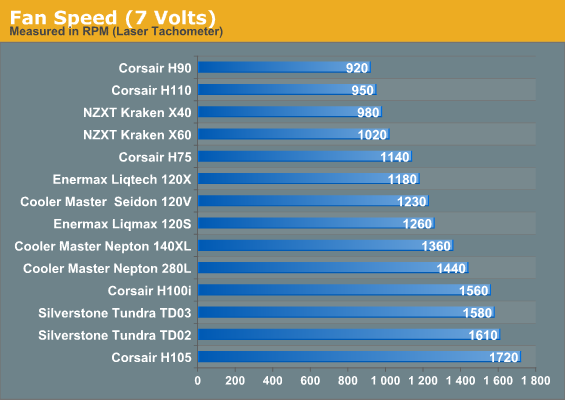
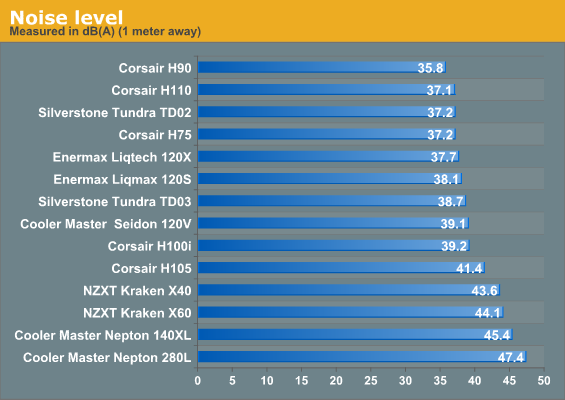
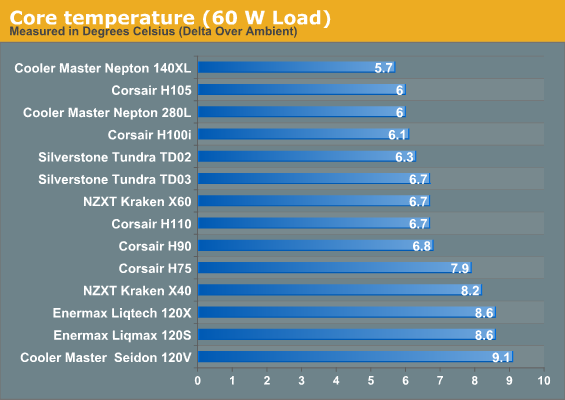

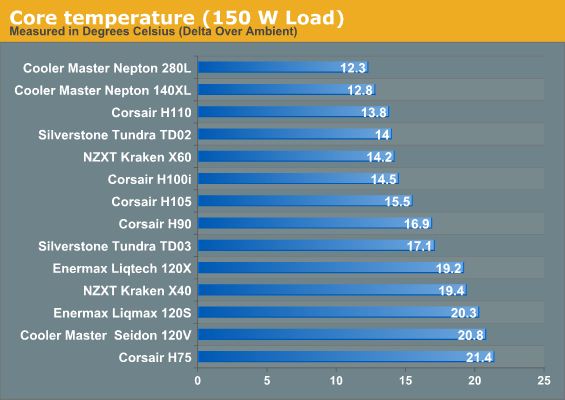
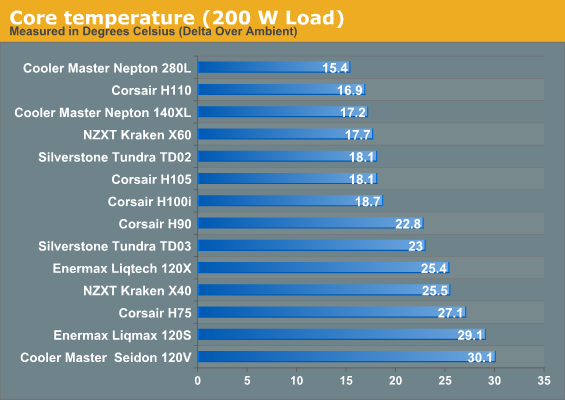
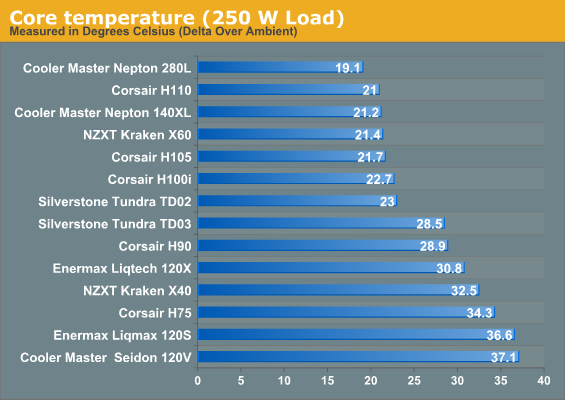
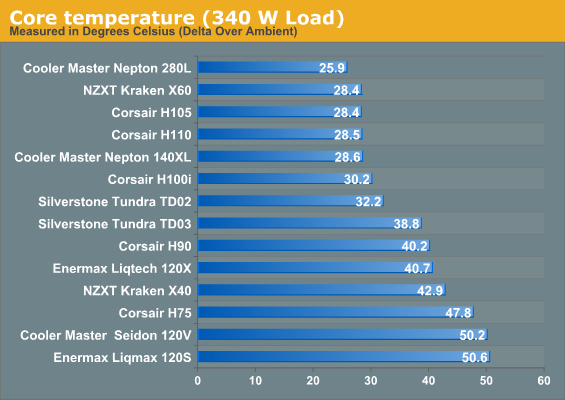
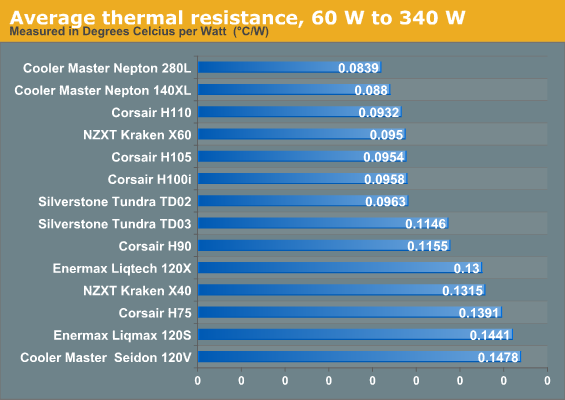
After dropping the voltage of the fans down to 7V, the characteristic performance of several AIO coolers changes quite a bit. As expected, the performance gap between most single and dual fan radiator models widens, as the larger surface maintains a greater heat dissipation rate as the flow rate decreases. The charts are once again led by Cooler Master's Nepton coolers, although that hardly qualifies as "low noise testing" as both coolers still generate high noise levels and are most definitely unsuitable for a low noise environment.
Corsair's H110 displays tremendous thermal performance under very heavy load, in conjunction with very low noise levels. NZXT's Kraken X60 delivers about the same thermal performance, which was to be expected as it virtually is the same design, yet the noise levels are significantly higher; apparently, Corsair chose their fans a bit more wisely (or they just got lucky). Silverstone's Tundra TD02 also fares considerably better this time, rivaling the high load thermal performance of all other 240mm coolers at considerably lower noise levels. Under low thermal loads, the Tundra TD02 manages to outperform most of the dual 120mm and 140mm coolers. Apparently, the large and thick radiator of the TD02 allows it to maintain high performance figures even when the airflow is reduced.
Those who are interested only in noiseless operation and are looking at AIO coolers as a high-performance, low noise alternative to CPU coolers should be careful with their selections. It is not always possible to reduce the speed of the stock fans or replace them in order to reduce the noise generated by the kit. For example, the fan of the Cooler Master Seidon 120V is virtually noiseless when its voltage is dropped down to 7V; the pump however is not, making a clearly audible, high pitch noise. This is also true for the Enermax Liqmax 120S, as the pump of this kit makes a whining noise as well, although the noise of its pump is significantly lower. On the other hand, the Corsair H90 is not the best performing or, due to its size, the most convenient kit of the roundup, yet it is entirely silent when its fan's voltage is reduced down to 7 Volts.










139 Comments
View All Comments
BlakKW - Friday, February 14, 2014 - link
Nice round-up E.Fyll...congrats on your new spot. Its a fine line between answering questions in the Comments section, and getting sucked into it...be cautious :)MushroomBomb - Friday, February 14, 2014 - link
Disappointed not seeing any Thermaltake Water, especially with their 3.0 offering, pretty sure they would be able to compete here.Bap2703 - Tuesday, February 18, 2014 - link
One should take care that the testing setup is in no way providing a "core" temperature despite being written on every graph :/aggiechase37 - Friday, February 21, 2014 - link
I've had the stock Intel fan on a 4770, and was getting temperatures in the 90's while rendering video. Thanks to this article, I've got the Corsair h90 on the way. Thanks guys!Valentini - Saturday, December 20, 2014 - link
Finally a truly meaningful test (the best test I have ever seen). In particular, indication of the thermal resistance is really great. The whole thing would be a little bit more accurate, if the indication of differences in temperature would be written in Kelvin instead of Celsius.pikunsia - Wednesday, August 5, 2015 - link
The difference in Kelvin (absolute) and Celsius (relative), as well as in Rankine (absolute) and Fahrenheit (relative) are the same! my friend. Please, let me show you, taking for example Celsius-Kelvin. Let T_C, T_K be temperatures in Celsius and Kelvin respectively. Thus,T_K1 = T_C1 + 273.15,
T_K2 = T_C2 + 273.15.
So,
DT_K = (T_C2 + 273.15) - (T_C1 + 273.15) = DT_C.
Now, if you're using thermodynamics Relations, for instance (in differential form),
Tds = dh - vdP,
where s, h, v, are the specific entropy, the specific enthalpy and the specific volume resp., the temperature T and the pressure P must be necessarily absolute, according to the Second Law of Thermodynamics.
ppsu - Friday, August 28, 2015 - link
It seems there is a new king in town and one of the only 360mm AIO liquid coolers on the market. Fractal Design's Kelvin S36 is an absolute stomper of a unit.http://www.performancepsu.com/the-best-aio-corsair...